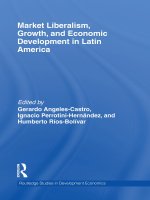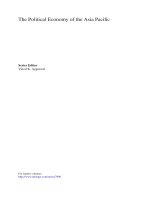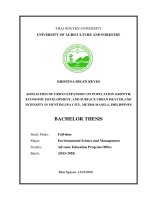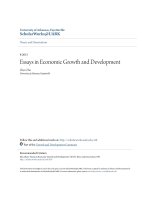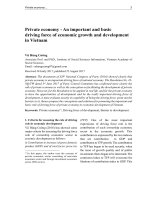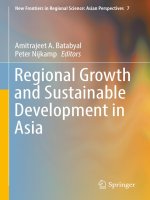Economic growth and economic development 713
Bạn đang xem bản rút gọn của tài liệu. Xem và tải ngay bản đầy đủ của tài liệu tại đây (90.5 KB, 1 trang )
Introduction to Modern Economic Growth
Exercise 15.12.
(1) Prove Proposition 15.7. In particular, use equation (15.9)
and show that when (15.37) is not satisfied, both free entry conditions
cannot hold simultaneously. Then show that if σ < 1/δ, there will be
greater incentives to undertake research for the technology that is relatively
scarce, and the opposite holds when σ > 1/δ.
(2) Interpret the economic significance of the condition σ < 1/δ. [Hint: relate
¢
¡
this to the fact that When σ < 1/δ, ∂ NHδ VH /NLδ VL /∂ (NH /NL ) < 0, but
the inequality is reversed when σ > 1/δ].
Exercise 15.13. Prove Proposition 15.8.
Exercise 15.14. Characterize the Pareto optimal allocation in the model with
knowledge spillovers and state dependence (Section 15.4). Show that the relative
technology ratio in the stationary Pareto optimal allocation no longer coincides with
the BGP equilibrium. Explain why this result differs from that in Section 15.3.
Exercise 15.15. Derive equation (15.42).
Exercise 15.16. Show that in the model of Section 15.5, if λ = 1, there exists no
BGP.
Exercise 15.17. Derive equations (15.43) and (15.44).
Exercise 15.18. Generalize the model of Section 15.4 so that there are no scientists
and the R&D sector also uses workers. Thus the labor market clearing condition is
R
LE (t) + LR
L (t) + LH (t) ≤ 0,
R
where LE (t) is employment in the production sector and LR
L (t) and LH (t) denote
the employment in the two R&D sectors.
(1) Define an equilibrium in this economy.
(2) Specify the free entry conditions for each machine variety.
(3) Characterize the BGP equilibrium, show that it is uniquely defined and
determine conditions such that the growth rate is positive and the transversality condition is satisfied.
(4) Show that the equivalents of Propositions 15.3 and 15.4 hold in this environment.
(5) Characterize the transitional dynamics and show that they are similar to
those in Proposition 15.2.
699
